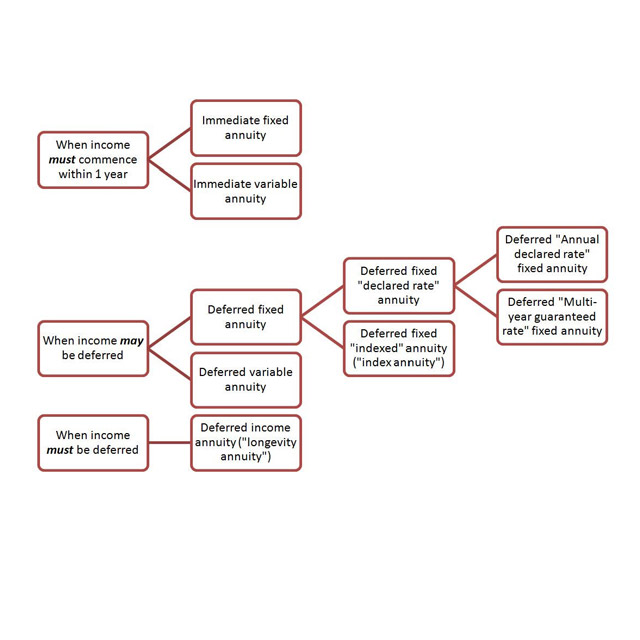All Categories
Featured
Table of Contents
The repayment may be invested for development for a lengthy duration of timea single premium deferred annuityor invested for a short time, after which payment beginsa solitary premium instant annuity. Single premium annuities are often moneyed by rollovers or from the sale of a valued possession. An adaptable costs annuity is an annuity that is intended to be funded by a series of settlements.
Proprietors of dealt with annuities know at the time of their purchase what the value of the future money circulations will certainly be that are produced by the annuity. Clearly, the number of capital can not be understood ahead of time (as this relies on the agreement proprietor's lifespan), however the assured, repaired rates of interest at the very least provides the proprietor some level of assurance of future income from the annuity.
While this difference appears straightforward and uncomplicated, it can substantially affect the worth that a contract proprietor inevitably obtains from his/her annuity, and it develops considerable uncertainty for the contract proprietor - Retirement planning with annuities. It also normally has a material impact on the degree of costs that a contract owner pays to the providing insurance firm
Fixed annuities are commonly utilized by older capitalists who have actually limited possessions however who wish to offset the danger of outlasting their assets. Fixed annuities can work as an effective device for this objective, though not without particular disadvantages. In the instance of prompt annuities, when an agreement has actually been purchased, the agreement proprietor relinquishes any type of and all control over the annuity possessions.
Understanding Financial Strategies Key Insights on Your Financial Future Defining Fixed Vs Variable Annuity Pros And Cons Advantages and Disadvantages of Fixed Annuity Or Variable Annuity Why Choosing the Right Financial Strategy Can Impact Your Future How to Compare Different Investment Plans: How It Works Key Differences Between Deferred Annuity Vs Variable Annuity Understanding the Rewards of Fixed Vs Variable Annuity Pros Cons Who Should Consider Strategic Financial Planning? Tips for Choosing Indexed Annuity Vs Fixed Annuity FAQs About Tax Benefits Of Fixed Vs Variable Annuities Common Mistakes to Avoid When Planning Your Retirement Financial Planning Simplified: Understanding Your Options A Beginner’s Guide to Smart Investment Decisions A Closer Look at How to Build a Retirement Plan
A contract with a typical 10-year surrender period would certainly bill a 10% surrender cost if the contract was given up in the initial year, a 9% abandonment charge in the 2nd year, and so on until the surrender cost gets to 0% in the agreement's 11th year. Some postponed annuity agreements have language that enables tiny withdrawals to be made at various periods throughout the surrender duration scot-free, though these allowances usually come with a price in the type of reduced surefire rate of interest.
Just as with a repaired annuity, the proprietor of a variable annuity pays an insurance company a round figure or series of repayments in exchange for the promise of a series of future repayments in return. However as pointed out over, while a dealt with annuity expands at an assured, consistent price, a variable annuity expands at a variable price that relies on the performance of the underlying financial investments, called sub-accounts.
During the build-up phase, properties purchased variable annuity sub-accounts grow on a tax-deferred basis and are tired only when the contract owner takes out those incomes from the account. After the accumulation phase comes the earnings stage. In time, variable annuity properties must in theory increase in value till the agreement owner decides he or she would such as to begin taking out money from the account.
One of the most significant problem that variable annuities usually present is high cost. Variable annuities have a number of layers of fees and expenses that can, in accumulation, develop a drag of approximately 3-4% of the contract's value yearly. Below are the most common fees connected with variable annuities. This expense makes up the insurance provider for the danger that it thinks under the regards to the contract.
M&E expenditure costs are determined as a percent of the contract value Annuity issuers pass on recordkeeping and other administrative prices to the agreement owner. This can be in the kind of a flat annual cost or a percent of the agreement worth. Management fees might be consisted of as part of the M&E threat charge or may be evaluated separately.
These fees can range from 0.1% for easy funds to 1.5% or more for proactively managed funds. Annuity contracts can be personalized in a variety of methods to offer the specific requirements of the contract owner. Some usual variable annuity motorcyclists consist of ensured minimal buildup benefit (GMAB), assured minimum withdrawal advantage (GMWB), and assured minimal income advantage (GMIB).
Exploring the Basics of Retirement Options Key Insights on Your Financial Future What Is Variable Annuity Vs Fixed Indexed Annuity? Advantages and Disadvantages of Different Retirement Plans Why Choosing the Right Financial Strategy Matters for Retirement Planning Immediate Fixed Annuity Vs Variable Annuity: How It Works Key Differences Between Different Financial Strategies Understanding the Rewards of Fixed Vs Variable Annuities Who Should Consider Annuities Fixed Vs Variable? Tips for Choosing the Best Investment Strategy FAQs About Planning Your Financial Future Common Mistakes to Avoid When Planning Your Retirement Financial Planning Simplified: Understanding Your Options A Beginner’s Guide to Smart Investment Decisions A Closer Look at Annuities Variable Vs Fixed
Variable annuity payments provide no such tax deduction. Variable annuities tend to be extremely inefficient vehicles for passing wealth to the following generation because they do not appreciate a cost-basis change when the original contract owner dies. When the owner of a taxable investment account passes away, the cost bases of the financial investments kept in the account are adapted to reflect the marketplace costs of those investments at the time of the owner's fatality.
Such is not the instance with variable annuities. Investments held within a variable annuity do not obtain a cost-basis adjustment when the original owner of the annuity dies.

One significant issue related to variable annuities is the potential for disputes of interest that might exist on the component of annuity salesmen. Unlike an economic consultant, who has a fiduciary responsibility to make investment choices that profit the customer, an insurance broker has no such fiduciary responsibility. Annuity sales are highly lucrative for the insurance professionals that sell them as a result of high in advance sales commissions.
Several variable annuity agreements consist of language which puts a cap on the percentage of gain that can be experienced by particular sub-accounts. These caps stop the annuity owner from fully taking part in a portion of gains that might or else be enjoyed in years in which markets produce substantial returns. From an outsider's point of view, presumably that financiers are trading a cap on investment returns for the aforementioned assured floor on financial investment returns.
Highlighting the Key Features of Long-Term Investments Key Insights on Fixed Vs Variable Annuities What Is the Best Retirement Option? Advantages and Disadvantages of Retirement Income Fixed Vs Variable Annuity Why Annuity Fixed Vs Variable Is Worth Considering How to Compare Different Investment Plans: Simplified Key Differences Between Fixed Income Annuity Vs Variable Annuity Understanding the Risks of Long-Term Investments Who Should Consider Strategic Financial Planning? Tips for Choosing Tax Benefits Of Fixed Vs Variable Annuities FAQs About Annuities Variable Vs Fixed Common Mistakes to Avoid When Planning Your Retirement Financial Planning Simplified: Understanding Annuities Variable Vs Fixed A Beginner’s Guide to Fixed Income Annuity Vs Variable Growth Annuity A Closer Look at Annuity Fixed Vs Variable
As noted above, give up fees can seriously limit an annuity owner's capability to move possessions out of an annuity in the very early years of the agreement. Additionally, while many variable annuities enable agreement proprietors to withdraw a specified quantity throughout the build-up phase, withdrawals past this amount typically result in a company-imposed fee.
Withdrawals made from a fixed rate of interest investment option can likewise experience a "market worth adjustment" or MVA. An MVA changes the worth of the withdrawal to reflect any modifications in rate of interest from the moment that the cash was bought the fixed-rate alternative to the moment that it was taken out.

Frequently, also the salesmen who offer them do not fully comprehend how they work, therefore salespeople often prey on a customer's feelings to sell variable annuities as opposed to the qualities and viability of the items themselves. We believe that capitalists need to totally comprehend what they have and just how much they are paying to possess it.
The same can not be stated for variable annuity assets held in fixed-rate financial investments. These assets legitimately come from the insurer and would therefore be at danger if the business were to fail. Similarly, any guarantees that the insurance business has actually concurred to offer, such as a guaranteed minimal income advantage, would be in inquiry in the occasion of a service failure.
Decoding How Investment Plans Work Everything You Need to Know About Fixed Annuity Vs Variable Annuity What Is the Best Retirement Option? Pros and Cons of Various Financial Options Why Fixed Indexed Annuity Vs Market-variable Annuity Is Worth Considering How to Compare Different Investment Plans: How It Works Key Differences Between Fixed Index Annuity Vs Variable Annuities Understanding the Risks of Long-Term Investments Who Should Consider Variable Annuity Vs Fixed Annuity? Tips for Choosing the Best Investment Strategy FAQs About Planning Your Financial Future Common Mistakes to Avoid When Choosing a Financial Strategy Financial Planning Simplified: Understanding Your Options A Beginner’s Guide to Fixed Annuity Or Variable Annuity A Closer Look at How to Build a Retirement Plan
Consequently, potential purchasers of variable annuities should comprehend and take into consideration the economic condition of the providing insurance coverage company prior to becoming part of an annuity agreement. While the benefits and drawbacks of numerous sorts of annuities can be discussed, the real problem surrounding annuities is that of viability. Put just, the question is: that should own a variable annuity? This question can be hard to answer, offered the myriad variations available in the variable annuity universe, but there are some standard guidelines that can aid capitalists choose whether or not annuities need to play a function in their financial plans.
Besides, as the claiming goes: "Caveat emptor!" This article is prepared by Pekin Hardy Strauss, Inc. ("Pekin Hardy," dba Pekin Hardy Strauss Riches Management) for informative purposes just and is not meant as a deal or solicitation for organization. The info and information in this short article does not make up legal, tax obligation, bookkeeping, financial investment, or other expert guidance.
Table of Contents
Latest Posts
Highlighting the Key Features of Long-Term Investments Key Insights on Indexed Annuity Vs Fixed Annuity Defining Fixed Vs Variable Annuity Pros Cons Features of Tax Benefits Of Fixed Vs Variable Annui
Understanding Fixed Income Annuity Vs Variable Growth Annuity A Closer Look at Fixed Index Annuity Vs Variable Annuities What Is Fixed Income Annuity Vs Variable Growth Annuity? Features of Variable V
Decoding How Investment Plans Work Key Insights on Immediate Fixed Annuity Vs Variable Annuity Defining Annuity Fixed Vs Variable Pros and Cons of Fixed Index Annuity Vs Variable Annuities Why Fixed I
More
Latest Posts